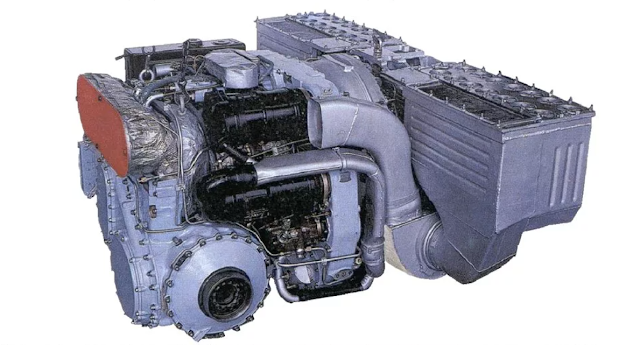Experimental muzzle protection devices for T-54 and T-62 tanks
The introduction of larger calibre cannons in the Soviet Union during the 1950s created a major problem, being that long barrels would tend to strike the ground in front and get either damaged or fully blocked by debris, this obstruction could cause barrel bloating or even catastrophic failure. This problem was primarily associated with the lack of vertical stabilization for cannons at the time. This became apparent with early production T-54s fielding the D-10T, which at the time was not stabilized and when traversing terrain with various dips, would often strike the ground.
From 1952 up until 1957, various muzzle protectors were designed and tested for the T-54. One of the designs was a device that was mounted on the end of the D-10T and had open slits, which prevented the barrel from being directly blocked by stuck debris.
 |
| T-54 barrel strikes the ground during the obstacle course. The barrel was shortened to 855mm. 1957. |
 |
| T-54 with experimental muzzle protector. |
 |
| Results of blocked muzzle protector |
In 1956, a rather interesting solution was proposed to clean out barrels if they struck the ground and were blocked. It was evaluated the average length of blockage was about 250 to 500mm. The solution was to use a signal relay to notify the crew of barrel blockage. A cleaning charge (in essence a blank shell) was to be used to clean out the barrel. This solution was only a stop-gap for peacetime situations.
The 2nd development wave of muzzle protectors started on the 7th of December 1965, with an official design contest on the best muzzle protector for the 115mm U-5TS. In 1966-1967 a variety of different designs were submitted, ranging from open or closed devices along with stabilizer improvements.
K. K. Shevchenko's proposed design (Ministry of Defence) was offered in 2 variants. The 1st variant was a contact-based barrel protector. The mechanism would only actuate when the barrel made contact with the ground and a protective shroud closed the barrel preventing it from firing. The 2nd variant used a direct link with the gunner's electric firing circuit. The protector was also different and used petals, which would open when the gunner activated the electric firing circuit. After firing the petals would return to their original position using springs.
V. N. Aviev's design (TsNIITochMash) was also showcased in 2 variants. Variant 1 used 2 covers mounted perpendicular to the barrel. When the barrel strikes the ground, the lower cover (shaped like a scoop) traverses on a vertical axis and drags the upper cover along with it. The motion of both covers closes the barrel from the front. The 2nd variant only differed in the design of the axial mechanism.
 |
| V. N. Aviev's barrel protector design on T-62 |
 |
| Close-up of the barrel protector when opened |
 |
| Close-up of the barrel protector when closed |
The following design solution was proposed by a group of engineers; I. M. Troshkov, V. V. Komarov, E.V. Razumov and L. N. Obozhin. The barrel protector used 2 lids mounted parallel to the barrel, a lever sensor was mounted underneath the muzzle and would only be actuated when coming in contact with the ground, closing the lids in front of the barrel. Springs were used to open the lids after the pressure from the lever sensor was lifted.
 |
| I. M. Troshkov, V. V. Komarov, E.V. Razumov and L. N. Obozhin muzzle protector design |
N. Ya. Trofimov was one of several engineers who proposed to use a sealed muzzle protector. His proposed design operated using gasses after firing the gun. Gases were diverted from the barrel into a chamber, which used the pressure to traverse the lids.
V. T. Zubtsov created a more complex sealed system. It was a cylindrical adaptor with 2 lids, which would open when firing the main cannon using the ogive of the shell, through a series of levers.
A. D. Rechnov had a more successful design. The protector was fitted with 12-section covers mounted inside of a housing relative to the barrel. When firing, the covers would open towards the projectile using the internal forces during cannon roll-back. The lids would close again using springs.
.png) |
| A. D. Rechnov's barrel protector design |
 |
| Close-up of the design |
S. V. Sidorov's project was presented in two versions. The 1st variant was a removable muzzle adaptor with spring-loaded lid sections enclosed within the housing. The opening of the lids was done using gasses in front of the projectile or could also be operated using the shells ogive shape. The other proposed design used a muzzle sensor, which was directly linked to the vertical cannon drives. When the barrel came in contact with the ground a signal would be converted to move the barrel higher.
 |
| S. V. Sidorov's project sketch |
The last design proposal was by V. P. Kondratiev. The design used 2 closing lids, mounted vertically inside a housing. The lids would open using inertial force during cannon roll-back. To soften the impact of the lids, the remaining were diverted through adjustable holes. The lids were also spring-loaded to return to a closed position.
 |
| V. P. Kondratiev's design sketch |
At the end of the design contest, none of the chosen designs that had been tested were able to meet the requirements. In the end, the problem of ground strikes was solved with more improved electric stabilizer drives.
- Павлов М. В., Павлов И. В. Отечественные бронированные машины 1945-1965 гг. Часть I. Легкие, средние и тяжелые танки.
- Журнал Техника и Вооружение. Но.08 2024



Comments
Post a Comment